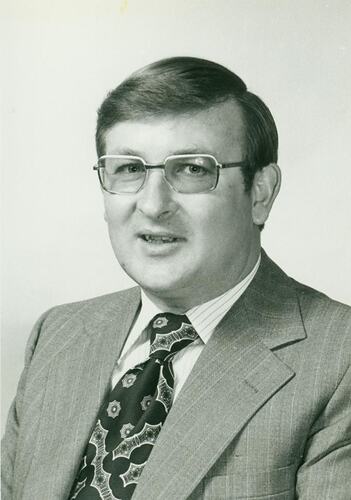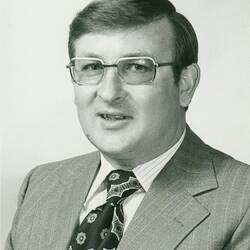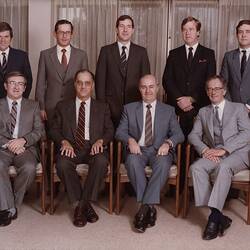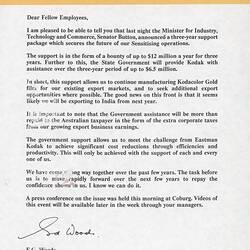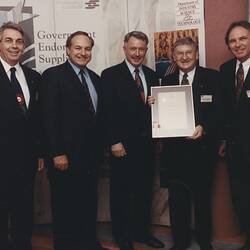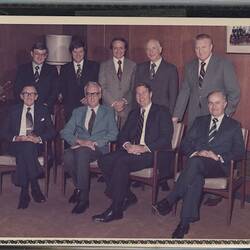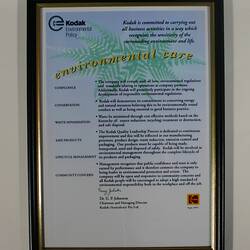Summary
From Scientist to Managing Director, 1968 - 1998.
Dr Gerry Johnston, Kodak Australasia Pty Ltd: From Scientist to Managing Director, 1968 - 1998
After completing a PhD in nuclear physics at the University of Melbourne in 1968, Dr Gerry Johnston looked for a job. Although he enjoyed research, he found 'the demand for nuclear physicists was very low'. Besides, he had ambitions to move into manufacturing or business. In those days Kodak Australasia employed PhD science graduates as a strategy for recruiting future managers. Not only was science a key aspect of the photographic industry, but the skills and discipline acquired in undertaking doctoral research could be applied in managerial roles. Gerry accepted a job as a research scientist at Kodak's Coburg plant.
Early career in research
At Kodak research was essential to the highly technical process of making film. Scientists were needed to solve problems that occurred during manufacture, to maintain quality control and to assist with the introduction of new products from overseas. Gerry's first research project involved photometry, a branch of physics concerned with the measurement of light. His task was to examine the spectral energy distribution for Australian daylight, with the object of comparing it with measurements of daylight in other places around the world. From his research Gerry concluded that the difference was too small to require any adjustment to the manufacture of Kodachrome film in Australia.
Gerry believes that his research led to his move to the Testing Department, where he was responsible for quality control of Kodachrome film and processing. He was subsequently promoted to head of the department, which was 'very definitely a step right away from science into management'.
Moving up the management ladder
In the 1970s Gerry moved up through the management ranks. He managed the Colour Print and Processing Division, which employed around 1200 people in Kodak's film processing laboratories in capital cities throughout Australia. He subsequently became Assistant General Manager Marketing Division, an area that was new to him. It was usual for Kodak to send up-and-coming managers overseas to gain experience with the parent company, Eastman Kodak in Rochester USA. So Gerry and his family moved to Rochester for two years, where he was Director of Business Planning for Asia, Africa and Australasia (the AAA Region). This job involved visiting Kodak companies in the region to see how they were performing and find out how Eastman Kodak could assist them.
In 1982 Gerry returned to Australia as General Manager Marketing. He later became Deputy Managing Director along with Ziggy Switkowski. Gerry had responsibility for the administration and distribution side of the company. In the late 1980s, as a senior executive he took part in negotiating a three year manufacturing support package, or bounty, with the Federal and State governments. At the time Eastman Kodak planned to close the Coburg plant because the Australian-made film was less profitable than film produced in the USA, mainly due to US tax concessions. Kodak Australasia was Australia's second largest exporting manufacturer and the Australian government was keen to encourage exports. Kodak's management team, led by Managing Director Ed Woods, was able to convince the government that they would repay the bounty many times over in export revenue, tax on corporate profits and the saving of 500 jobs. The bounty, granted in 1989, enabled Kodak Australasia to improve productivity and expand export markets. This was a great success story for Kodak Australasia, and Gerry is proud to have contributed.
Managing Director
In 1996 Gerry succeeded Ziggy Switkowski as Managing Director, a role that had become, according to Gerry, 'something of a figurehead', rather than hands on. One of Gerry's achievements was to decide to challenge the Taxation Department over a requirement to pay sales tax on developed film. In the days before GST, sales tax was levied on manufactured goods, but not on second-hand goods. Kodak argued that the exposed film was second-hand after it was processed. The case ended up in the High Court, which found in Kodak's favour and ordered the sales tax to be refunded. Gerry regarded this as a personal highlight.
Although Kodak Australasia had saved 500 manufacturing jobs in 1989, by the mid 1990s sales of film were declining as digital photography grew in popularity. This meant redundancies in the operations, distributions and administrative areas. Gerry reflects on the unpleasant task:
"You try to do it the best way possible but I found out you can't please everyone. I always felt that the maximum notice would be what people wanted, but in fact a few people complained to me that they felt like they were left hanging because they knew it was happening in three months' time, but meanwhile what do they do? So there's the sudden death method or the reasonable notice method. I would prefer notice but some people don't."
In Gerry's last year as Managing Director, he received a directive from Rochester to reduce senior management by about a third, so he had unenviable job of making a number of his colleagues redundant. He believes he negotiated with Rochester for good redundancy packages for them. Gerry was approaching retirement, but planned to stay on until after the Sydney Olympics in 2000, of which Kodak was a major sponsor. However in 1998 he was offered a redundancy package, which he decided to accept.
References
Beale, Nigel, 'The History of Kodak in Australia', 1983 (unpublished manuscript).
HT 36622 - Interview with Dr Gerry Johnston, interviewed by Lesley Alves 5 March 2014
More Information
-
Keywords
Manufacturing, Photographic Products, Biographies, Managers, Scientists
-
Authors
-
Article types
